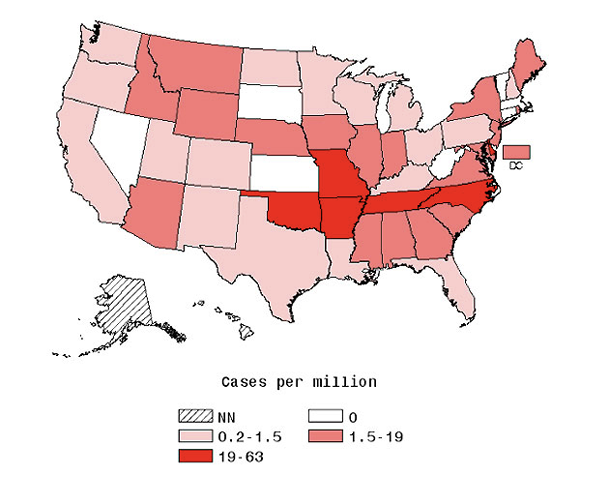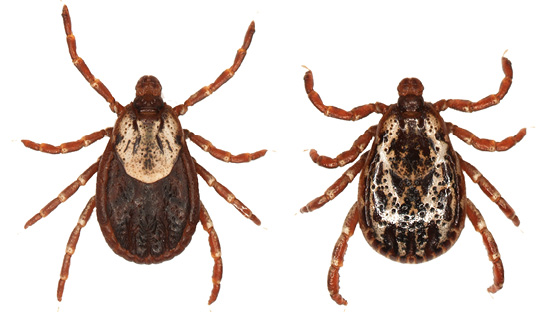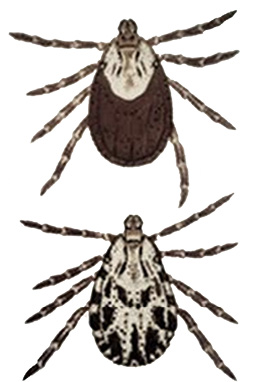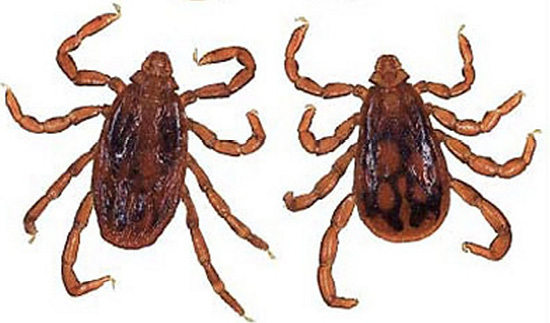Rocky Mountain Spotted Fever: How to Protect Yourself
In the late 1800s, Rocky Mountain spotted fever (RMSF) was the first human tick-borne disease identified in the United States. The disease was recognized in the Bitterroot Valley of Montana, which is why it was named RMSF, but eventually it became apparent that most cases actually were distributed throughout the eastern United States.
The American dog tick, Dermacentor variabilis, is the most important vector (carrier) of the bacteria that cause RMSF in the eastern United States (Table 1). In the western United States, the vector is the Rocky Mountain wood tick, Dermacentor andersoni. Recently, the brown dog tick, Rhipicephalus sanguineus, was implicated as a vector for RMSF in parts of Arizona.
In the United States, most cases of RMSF occur in the southeastern and south-central states, particularly Arkansas, Missouri, North Carolina, Oklahoma, and Tennessee, which account for more than half of all reported cases (Figure 1). In the last two decades, cases of RMSF reported to the Centers for Disease Control and Prevention (CDC) increased from 345 cases in 1993 to 2,553 cases in 2008. In Mississippi, case numbers range from about 10 to 70 per year, with an average of about 30.

Symptoms of RMSF usually appear within 2 to 9 days after an infected tick bites a person (not all ticks have the germ). Early disease is difficult to diagnose. Patients may experience a variety of symptoms, including sudden fever (90 percent), severe headache (89 percent), muscle pain (83 percent), and rash (78 percent). The rash may even occur on the palms (50 percent) and soles of the feet. On the other hand, the rash may be indistinct or not present at all when a physician initially examines a patient. The classic rash of RMSF does not appear until about 5 to 6 days after the tick bite. RMSF is very treatable with certain antibiotics if diagnosed early, but it can be fatal in some cases if left untreated or if the wrong medicine is prescribed.
Children are particularly at risk for RMSF, with two-thirds of all cases occurring in people younger than 15. The highest rate is in children ages 5 to 9. Children with RMSF may experience nausea, vomiting, and loss of appetite. Children are less likely to report a headache but more likely to develop an early rash than adults. Other frequently observed signs and symptoms in children with RMSF are abdominal pain, altered mental status, and red eyes. Occasionally, symptoms like cough, sore throat, and diarrhea may be seen, which can lead to misdiagnosis.
RMSF Is Reportable
RMSF is a nationally reportable disease (except in Alaska and Hawaii). That means physicians must report suspected cases to their health department. Proper laboratory testing and reporting can help bring aid to high-risk communities and limit the spread of RMSF. In order to confirm a diagnosis of RMSF, a special test must be performed on two blood samples taken 3 weeks apart. The first sample should be taken as early in the disease as possible, preferably in the first week of symptoms. In a true case of RMSF, the first result is typically low or “negative” and the second result shows a significant increase in antibodies. For information and questions about reporting cases, contact your local health department’s epidemiology division.
Common Ticks That Can Transmit RMSF
American Dog Tick
Dermacentor variabilis
The American dog tick is one of the most widely distributed and common ticks in the eastern and central United States and parts of the West Coast. Adult American dog ticks feed on medium to large animals, people, and their pets. They are reddish-brown and have silvery-gray or whitish markings on their backs or upper bodies (Figure 2). Adults are almost one-fourth of an inch long, so they are usually easy to see. Female ticks increase dramatically in size as they obtain their blood meal from a host animal, reaching half an inch in length and resembling a dark pinto bean.

Dogs are the preferred hosts of adult American dog ticks, but they also feed readily on other mammals, such as opossums, raccoons, skunks, foxes, coyotes, bobcats, cattle, sheep, horses, and people. The immature stages of the tick (larva and nymph) feed on meadow voles, white-footed mice, and other small rodents. In Mississippi, adult ticks are active from about mid-March to mid-October, with peak activity in August. Mating occurs on the host.
Adult female ticks will feed for 10 to 12 days. Once the female is engorged with blood, she drops off the host and deposits 3,000 to 7,000 eggs (average around 5,000) on the ground. Males continue to ingest small amounts of blood from the host. Because of climate differences, the American dog tick requires about 2 years to complete its life cycle in the northeastern United States, as opposed to only 1 year in the South.
American dog ticks are most numerous along roadsides, paths, marshy areas, and trails in brushy woodlands, or in meadows with tall grass or weeds. People or their pets may bring these ticks from outdoors into the home, where they can survive for many days. However, these ticks will not become established indoors.
Rocky Mountain Wood Tick
Dermacentor andersoni
The Rocky Mountain wood tick is found in western North America from about British Columbia and Saskatchewan south through North Dakota to northern New Mexico, Arizona, and California. It looks similar to the American dog tick but is not found in Mississippi (Figure 3).

The immature stages prefer to feed on a variety of small mammals, such as ground squirrels, chipmunks, meadow mice, woodchucks, and rabbits, while the adults feed mainly on larger animals, such as cattle, sheep, deer, elks, dogs, and humans. Adults become active in February or March, peak in April and May, and decline by July. The normal life cycle requires 1 or 2 years. Unfed adult ticks may survive for more than 2 months. The female tick may lay more than 7,000 eggs.
Brown Dog Tick
Rhipicephalus sanguineus
The brown dog tick or kennel tick is found almost worldwide and throughout the entire United States (Figure 4). Domestic dogs are the principal host for all three stages (larva, nymph, adult) of the tick, especially in the United States, although the tick feeds on other hosts in other parts of the world. On dogs, adult ticks feed mainly inside the ears, on the head and neck, and between the toes, while the immature stages may feed almost anywhere on the dog, including the neck, legs, chest, and belly. People may occasionally be attacked.

This tick is often found in yards, homes, kennels, and small-animal hospitals where dogs are present, particularly in pet bedding areas, although in the North, this tick is found almost exclusively indoors. The brown dog tick is the species involved in almost all household tick infestations. They may be observed crawling around baseboards or up the walls or other vertical surfaces of infested homes, seeking protected areas, such as cracks, crevices, spaces between walls, or behind wallpaper, to molt or lay eggs.
A female tick can deposit 300 to 3,000 eggs. Under favorable conditions, the life cycle can be completed in about 2 months. Brown dog ticks infected with the agent of Rocky Mountain spotted fever recently have been recovered in Arizona, where an outbreak of the disease occurred.
How to Protect Yourself from RMSF
Although we know that all three RMSF vector species prefer to feed on dogs, they readily bite people, too. However, since the primary food source, especially for the American dog tick and the brown dog tick, consists of blood meals from dogs, they could not continue to infest an area without untreated dogs on which to feed. Therefore, effectively treating every dog in the community for ticks could help the problem.
However, once ticks have infested an area, they can live in the environment without feeding for long periods of time, so houses and yards also need to be treated with residual pesticides. Many products, such as those containing permethrin and other pyrethroids, are labeled for tick control in and around homes. Be sure to follow the pesticide label directions. Most pesticides do not kill tick eggs, so all environmental treatments may need to be repeated monthly to effectively break the cycle of newly emerging stages. Tick collars on dogs need to be replaced every 3 months to kill newly hatching ticks continuously.
Ideally, everyone in the community should work together so tick problems won’t persist and the risk of RMSF will be reduced.
|
Common name |
Species |
Distribution |
|---|---|---|
|
American dog tick |
Dermacentor variabilis |
Eastern United States and parts of the West Coast |
|
Rocky Mountain wood tick |
Dermacentor andersoni |
Rocky Mountain states south to New Mexico and Arizona |
|
Brown dog tick |
Rhipicephalus sanguineus |
All over United States and worldwide |
Publication 2808 (POD-01-20)
By Jerome Goddard, PhD, Extension Professor, Biochemistry, Molecular Biology, Entomology, and Plant Pathology, and Kristine T. Edwards, PhD, former Senior Extension Associate, Biochemistry, Molecular Biology, Entomology, and Plant Pathology.
The Mississippi State University Extension Service is working to ensure all web content is accessible to all users. If you need assistance accessing any of our content, please email the webteam or call 662-325-2262.


